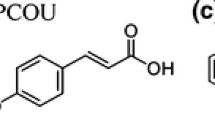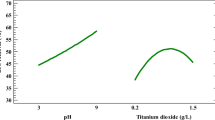Abstract
m-Dinitrobenzene, diphenylamine and resorcinol, threearomatic compounds found inhibitory or recalcitrant tobiological treatments, were chosen as model chemicalsfor this study on the integration ofphotocatalytic-biological treatments. The degradationof each of these compounds was achieved by ultravioletphotocatalytic oxidation, leading to the formation ofintermediate compounds. The photocatalytic treatmentwas performed in a TiO2 slurry reactor containingan aqueous solution of one of the three chemicals. Thebiodegradability of model wastewater treatedphotocatalytically was measured in terms ofBOD1/TOC. Intermediate compounds that appeared atearly stages of the photocatalytic degradation ofm-dinitrobenzene or diphenylamine seemed to be moreinhibitory than the parent compounds but this was notthe case for resorcinol. A substantial improvement inBOD1/TOC could be achieved, but it required themineralization of at least 80% of the organic carbonoriginally in the water. Microtox® toxicityresults confirmed the BOD1/TOC trends fordiphenylamine.
Similar content being viewed by others
References
Cho SH & Bowers AR (1991) Treatment of toxic or refractory aromatic compounds by chemical oxidants. In: On-site bioreclamation: processes for xenobiotic and hydrocarbon treatment, Hinchee RE & Olfenbuttel RF (Eds), Butterworth-Heinemann, Boston
Parent Y, Blake D, Magrini-Bair K, Lyons C, Turchi C, Watt A, Wolfrum E & Prairie M (1996) Solar photocatalytic processes for the purification of water: state of development and barriers to commercialization. Solar Energy 56(5): 429–437
Malato Rodriguez S, Richter C, Blanco Gálvez J & Vincent M (1996) Photocatalytic degradation of industrial residual waters. Solar Energy 56(5): 401–410
Ollis DF, Pelizzetti E & Serpone N (1991) Destruction of Water Contaminants. Environ. Sci. Technol. 25(9): 1523–1529
Minero C, Pelizzetti E, Malato S & Blanco J (1996) Large solar plant photocatalytic water decontamination: degradation of atrazine. Solar Energy 56(5): 411–419
Pichat P (1994) Partial or complete heterogeneous photocatalytic oxidation of organic compounds in liquid organic or aqueous phases. Catalysis Today 19: 313–334
Scott JP & Ollis DF (1995) Integration of Chemical and Biological Oxidation Processes for Water Treatment: Review and Recommendations. Environmental Progress 14(2): 88–103
Manilal VB, Haridas A, Alexander R & Surender GD (1992) Photocatalytic Treatment of Toxic Organics in Wastewater: Toxicity of Photodegradation Products. Wat. Res. 26(8): 1035–1038
Tanaka S & Ichikawa T (1993) Effects of Photolytic Pretreatment on Biodegradation and Detoxification of Surfactants in Anaerobic Digestion. Wat. Sci. Tech. 28(7): 103–110
Sierka RA & Bryant CW (1994) Enhancement of Biotreatment Effluent Quality by Illuminated Titanium Dioxide and Membrane Pretreatment of the Kraft Extraction Waste Stream and by Increased Chlorine Dioxide Substitution. Wat. Sci. Tech. 29(5/6): 209–218
Takahashi N, Nakai T, Satoh Y & Katoh Y (1994) Variation of Biodegradability of Nitrogenous Organic Compounds by Ozonation. Wat. Res. 28(7): 1563–1570
Lu M-C, Roam G-D, Chen J-N & Huang CP (1993) Microtox bioassay of photodegradation products from photocatalytic oxidation of pesticides. Chemosphere 27(9): 1637–1647
Gulyas H, Bockelmann D, Hemmerling L, Bahnemann D & Sckoulov I (1994) Treatment of recalcitrant organic compound in oil reclaiming wastewater by ozone/hydrogen peroxide and UV/titanium dioxide. Wat. Sci. Tech. 29(9): 129–132
Minsker L, Pulgarin C, Peringer P & Kiwi J (1994) Integrated approach useful in the mineralization of nonbiodegradable, toxic p-nitrotoluenesulfonic acid via photocatalytic-biological processes. New J. Chem. 18(7): 783–800
Carey JH & Oliver BG (1980) The photochemical treatment of wastewater by ultraviolet irradiation of semiconductors. Water Poll. Res. J. of Canada. 15(2): 157–185
Ollis DF (1985) Contaminant Degradation in Water. Environ. Sci. Technol. 19(6): 480–484
Matthews RW (1988) Kinetics of Photocatalytic Oxidation of Organic Solutes over Titanium Dioxide. Journal of Catalysis 111: 264–272
Linsebigler AL, Lu G & Yates JT Jr (1995) Photocatalysis on TiO2 Surfaces: Principles, Mechanisms, and Selected Results. Chem. Rev. 95: 735–758
Serpone N (1994) A decade of heterogeneous photocatalysis in our laboratory: pure and applied studies in energy production and environemental detoxification. Res. Chem. Intermed. 20(9): 953–992
Hoffman MR, Martin ST, Choi W & Bahnemann DW (1995) Environmental Applications of Semiconductor Photocatalysis. Chem. Rev. 95: 69–96
Serpone N (1995) Brief Introductory Remarks on Heterogeneous Photocatalysis. Solar Energy Materials and Solar Cells 38: 369–379
Turchi CS & Ollis DF (1990) Photocatalytic Degradation of Organic Water Contaminants: Mechanisms Involving Hydroxyl Radical Attack. Journal of Catalysis 122: 178–192
Pelizzetti E, Minero C, Piccinini P & Vincenti M (1993) Photo-transformations of Nitrogen Containing Organic Compounds over Irradiated Semiconductor Metal Oxides. Nitrobenzene and Atrazine over TiO2 and ZnO. Coordination Chemistry Reviews 125: 184–194
Bekbölet M, Lindner M, Weichgrebe D & Bahnemann DW (1996) Photocatalytic detoxification with the thin-film fixedbed reactor (TFFBR): clean-up of highly polluted landfill effluent using a novel TiO2-photocatalyst. Solar Energy 56(5): 455–469
Pelizzetti E (1995) Concluding remarks on heterogeneous photocatalysis, Solar Energy Materials and Solar Cells 38: 453–457
Minero C, Pelizzetti E, Piccinini P & Vincenti M (1994) Photocatalyzed transformation of nitrobenzene on TiO2 and ZnO. Chemosphere 28(6): 1229–1244
Low GK-C, McEvoy SR & Matthews RW (1991) Formation of nitrate and ammonium ions in titanium dioxide mediated photocatalytic degradation of organic compounds containing nitrogen atoms. Environ. Sci. Technol. 25: 460–467
Schmelling DC & Gray KA (1995) Photocatalytic transformation and mineralization of 2,4,6-trinotrotoluene (TNT) in TiO2 slurries. Wat. Res. 29(12): 2651–2662
Maillard-Dupuy C, Guillard C & Pichat P (1994) The degradation of nitrobenzene in water by photocatalysis over TiO2: kinetics and products; simultaneous elimination of benzamide or phenol or Pb2+cations. New J. Chem. 18: 941–948
Schmelling DC, Gray KA & Kamat PV (1996) Role of reduction in the photocatalytic degradation of TNT. Environ. Sci. Technol. 30: 2547–2555
Dieckmann MS & Gray KA (1996) A comparison of the degradation of 4-nitrophenol via direct and sensitized photocatalysis in TiO2 slurries. Wat. Res. 30(5): 1169–1183
Standard Methods for the Examination of Water and Wastewater, 18th ed., 1992, edited by Greenberg AE, Clesceri LS and Eaton, AD, published jointly by APHA, AWWA and WEF
Kawaguchi H (1994) Dependence of Photocatalytic Reaction Rate on Titanium Dioxide Concentration in Aqueous Suspensions. Environmental Technology 15: 183–188
Low GK-C, McEvoy SR & Matthews RW (1989) Formation of ammonium and nitrate ions from photocatalytic oxidation of ring nitrogenous compounds over titanium dioxide. Chemosphere 19(10/11): 1611–162
Takeda K & Fujiwara K (1996) Characteristics on the determination of dissolved organic nitrogen compounds in natural waters using titanium dioxide and platinized titanium dioxide mediated photocatalytic degradation. Wat. Res. 30(2): 323–330
Dillert R, Brandt M, Fornefett I, Siebers U & Bahnemann D (1995) Photocatalytic degradation of trinitrotoluene and other nitroaromatic compounds. Chemosphere 30(12): 2333–2341
D'Oliveira J-C, Guillard C, Maillard C & Pichat P (1993) Photocatalytic destruction of hazardous chlorine-or nitrogen-containing aromatics in water. J. Environ. Sci. Health A28(4): 941–962
King EF & Painter HA (1981) Assessment of Toxicity of Chemicals to Activated Sludge Microorganisms. INSERM 106: 143–153
Author information
Authors and Affiliations
Rights and permissions
About this article
Cite this article
Bolduc, L., Anderson, W.A. Enhancement of the biodegradability of model wastewater containing recalcitrant or inhibitory chemical compounds by photocatalytic pre-oxidation. Biodegradation 8, 237–249 (1997). https://doi.org/10.1023/A:1008221222846
Issue Date:
DOI: https://doi.org/10.1023/A:1008221222846




